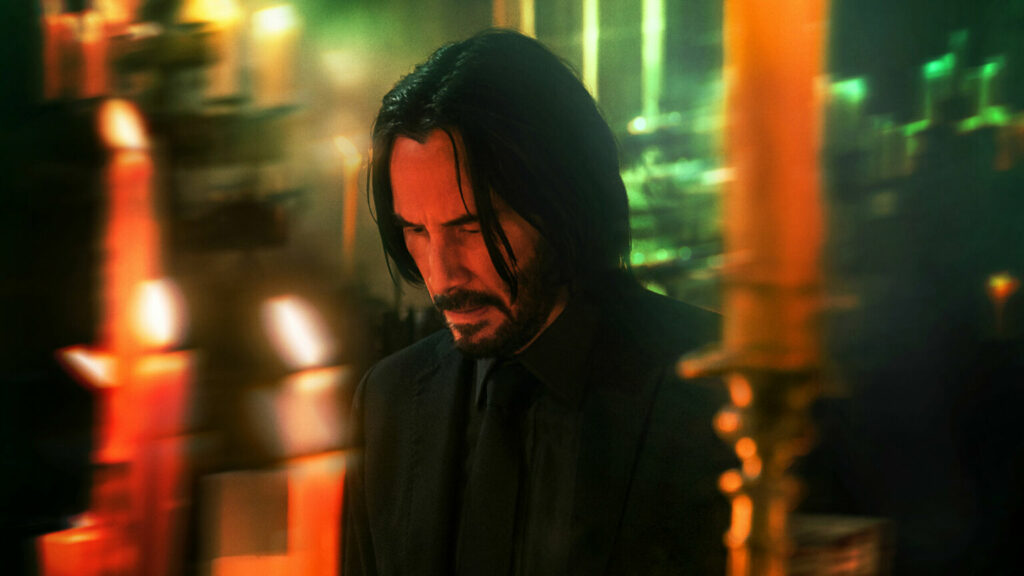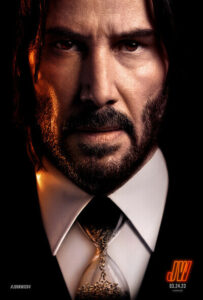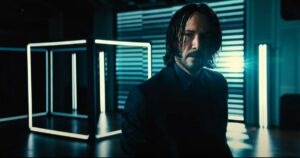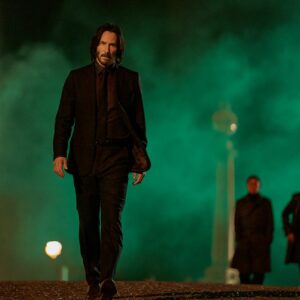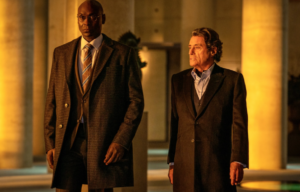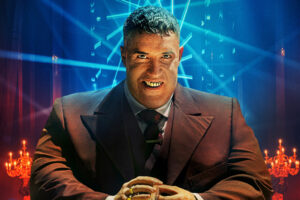Directed by Chad Stahelski | Written by Shay Hatten and Michael Finch, based on characters by Derek Kolstad | 169 min | ▲▲▲▲△ | Amazon Prime and Crave
When John Wick first found his bloody path to the big screen about a decade ago, it was a mid-budget indie action picture with a 50-year-old Keanu Reeves in the lead, a leading man whose last hit was the third Matrix movie, which had come out a decade before. Wick was an unexpected hit, it revived Reeves’ career and produced a couple sequels, John Wick: Chapter 2 in 2017 and John Wick: Chapter 3 – Parabellum in 2019. While some of the drama has become repetitive and a bit stale as its gone along, the action — the reason people come to this material, scenes of hand-to-hand combat — has remained unimpeachable.
You could say the John Wick series, with its combination of revenge thriller and Asian action influences, has lifted expectations for what action cinema should be. That’s a serious legacy.
And if this ends up the final film in the franchise — after the third one there were rumours of two more coming, but now they’ve got a spin-off, Ballerina, and a series, The Continental, in the pipeline — John Wick: Chapter 4 can stand tall as the best sequel of the bunch.
The filmmakers have doubled down on their genre antecedents — cinephiles are sure to recognize direct homages to Lawrence of Arabia, The Warriors, Mission Impossible: Rogue Nation, and Blow-Out — while expanding the scale. JW4 has more international locales than a Bond movie, including Wadi Rum in Jordan, New York, Japan, Studio Babelsberg in Potsdam, and multiple locations for the big finale in Paris.
At the end of the third movie, John was betrayed by one of his faithful pals, Winston (Ian McShane, a man with incredibly white choppers), the manager of the New York Continental hotel. Winston shot him and he fell five or six storeys, bouncing off roofs and awnings on the way down. No one could’ve survived that, but when we find John here he’s entirely healthy and able-bodied, hunting and dispatching more (presumably) bad men. That includes one of the High Table, the corrupt management board of the whole Wickiverse.
Though this group does have its badge-carrying representatives — a particularly skeevy Bill Skarsgaard plays one, The Marquis — in this hyper-gig economy they mostly they use a series of independent contractors, like John, to kill people. As we’ve seen in previous films a lot of these guys share plenty of professional courtesy and respect, sometimes even friendship.
On the scene this time is blind assassin Caine, played by Donnie Yen (of Ip Man fame, and who played another blind warrior in Star Wars: Rogue One), and Tracker, played by Shamier Anderson — both of whom are ostensible antagonists and support for John Wick, depending on the scene.
Also new in this one is the manager of the Osaka Continental, Shimazu, played by the legendary Hiroyuki Sanada, and his concierge (and daughter), Akira, played by pop star Rina Sawayama. We also get terrific support from solid character and action vets, Clancy Brown, Natalia Tena, Marko Zaror, Scott Adkins, and George Georgiou. Familiar faces return — Laurence Fishburne as the Bowery King, and the late, great Lance Reddick as Charon.
This stellar cast is plunked into the best-looking John Wick movie yet, an incredibly stylish action picture stuffed with high end sets, gorgeous lighting, and the kind of exotic and dreamy environments we’ve come to expect — everything looks like a former industrial spaced converted into a modern art gallery where a pop-up nightclub has taken over from the hours of midnight to 6am. Invariably we have John having to kill a long line of well-dressed enormous thugs around dancers too high or too into the music to care.
John Wick: Chapter 4 delivers the excellent spacial coherence that’s the hallmark of these films. With the possible exception of a scene around the Arc de Triomph with a lot of cars going in opposite directions, every action sequence is choreographed like an especially violent and graceful dance. Highlights include Wick getting his hands on a pair of nunchaku, and a high-calibre weapon that when unloaded basically sets his enemies on fire.
It’s not a perfect action picture, however. A few of the issues from the earlier sequels still linger, like the fact Wick seems to have so little agency as the protagonist of own story, just moving from one locale to another where he has to fight a whole new cadre of killers — the initial motivation for his revenge had long been left behind even if, thematically, the film is exploring revenge as a motivator in other characters. John’s slow but deliberate transformation into a nigh-invulnerable superhero also scuppers a lot jeopardy. We know John is gonna survive every scrape, kill every single opponent, until such time as he’s had enough.
Finally, when this epic does find its inevitable conclusion, there’s an unsatisfying arbitrariness to how it wraps up. I won’t say more than that, but I guess I hoped it would go a different way.
With that said, for a long while — and this is the longest one yet — John Wick: Chapter 4 is a blast.
And, yes, to explain that headline: Skyfall was the most visually impressive and emotionally satisfying of the Daniel Craig Bonds, and JW4 aims for something similar.





